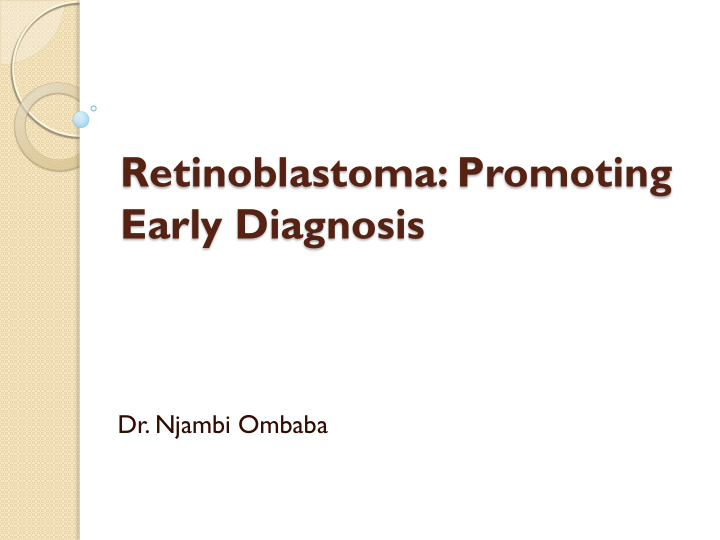



Retinoblastoma: Promoting Early Diagnosis Dr. Njambi Ombaba
Objectives Overview of the clinical presentation and treatment of retinoblastoma Understand causes of late presentation Outline ways of enhancing early diagnosis of childhood eye problems
Outline Introduction Clinical presentation and management Reasons for late diagnosis How to enhance early diagnosis and referral
Introduction • Childhood genetic, eye cancer arising from the retina • Typically occurs before 5 years of age • 60% unilateral; 40% bilateral; Rarely trilateral • 10% Family history
Presentation White reflex 60% Strabismus 25% Proptosis 50% Ocular inflammation 10%
Management Early diagnosis- key to cure High cure rate > 90 % if treated early Late presentation with metastasis - 100% mortality Standard treatment is enucleation
Other treatments • Focal laser/ cryotherapy : small tumours • Chemotherapy/ Radiotherapy Extra ocular and metastatic disease
Role of Counseling
Late diagnosis • Accessibility • Financial Late arrival • Cultural • Ignorance • Ignorance Missed • Dismiss parents diagnosis concern • Lost follow up Complex • Failure to track patients referral • Accessibility Reasons for late Presentation1 system • No direct referrals
Enhancing early diagnosis Raise MCH Direct awareness booklet referrals • Posters • Health facility with an • Childhood ophthalmologist blindness • Eye section booklet • Daisy Cancer Fund • RB Guidelines
Awareness Posters Guidelines
The MCH booklet
The eye section
Other Childhood Eye Problems
Utilization of eye section T oo demanding 0.8% Shortage Not of staff trained Print too small
Way forward Attitude Change; We can do it!
Summary Early diagnosis key to cure in retinoblastoma Any child with suspected eye problem need review by ophthalmologist Better utilization of MCH booklet to improve early detection
Thank you
Recommend
More recommend